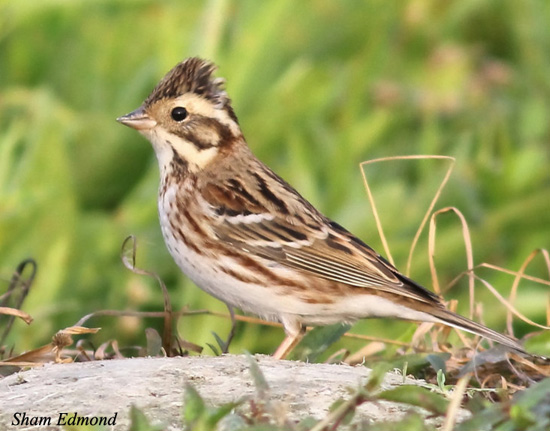| Length: 6 inches | Wingspan: 9 inches | Seasonality: Non-resident in South Dakota |
| ID Keys: Crest, breeding male with black head, white throat and supercilium, chestnut-brown upperparts and bib | ||
 The
Rustic Bunting is normally found in northern Europe and Asia, but they have
strayed to North America on occasion, with most records scattered up and
down the west coast of the U.S., Canada, and Alaska. They are found in
the western Aleutians somewhat regularly, but are still considered vagrants
in all of North America.
The
Rustic Bunting is normally found in northern Europe and Asia, but they have
strayed to North America on occasion, with most records scattered up and
down the west coast of the U.S., Canada, and Alaska. They are found in
the western Aleutians somewhat regularly, but are still considered vagrants
in all of North America.
Habitat: Found in moist evergreen forest during the summer breeding season. Found in a greater variety of habitats in migration and in winter, including forest clearings and edges, fencerows, shrubby fields, and other brushy areas.
Diet: Feeds primarily on seeds, but during the breeding season, also will feed on insects and other small invertebrates.
Behavior: Most foraging is done on the ground. During the summer breeding season, they will also glean insects from vegetation, moving deliberately through shrubs and other low plants.
Nesting: Nesting occurs low in a bush or on the ground, with the cup-shaped nest consisting of moss, grasses, and weed stems.The female lays between 3 and 6 eggs. Both the male and female incubate the eggs, and both parents help feed and tend to the young once they hatch.
Song: A sweet melodic warbling
Migration: Strongly migratory, breeding in northern Europe and Asia, and wintering in Japan, eastern China, and elsewhere in southeast Asia.
Feeders: Will readily attend feeders for commonly offered seeds, suet.
Interactive eBird map: Click here to access an interactive eBird map of Rustic Bunting sightings
Similar Species: Male in breeding plumage is rather distinctive, particularly compared to North American bird species. Both males and females could possibly be confused with the Reed Bunting, another Eurasian visitor to North America.
Conservation Status: Populations are likely declining, but overall, Rustic Buntings are found across a wide geographic area and total populations are strong. The IUCN lists the Rustic Bunting as a species of "Least Concern".
Further Information: 1) WhatBird - Rustic Bunting
2) Audubon - Rustic Bunting
3) British Trust for Ornithology - Rustic Bunting
Photo Information: Photo by Sham Edmond - Licensed under Creative Commons Attribution 2.0 Generic License.
| Click below for a higher-resolution map |
|
|
| South Dakota Status: Non-resident in South Dakota |
Additional Zone-tailed Hawk Photos (coming soon!!)
